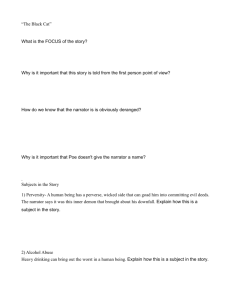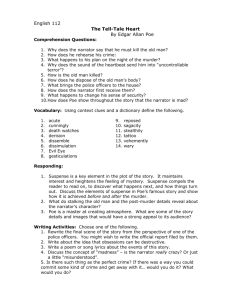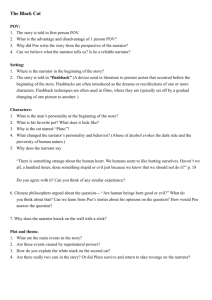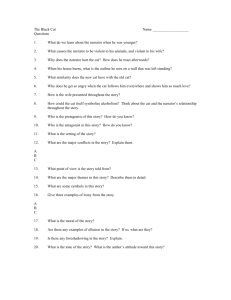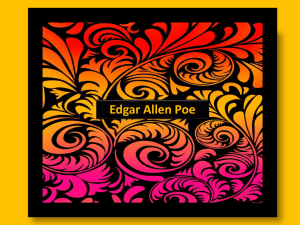This document has been downloaded from TamPub – The
advertisement
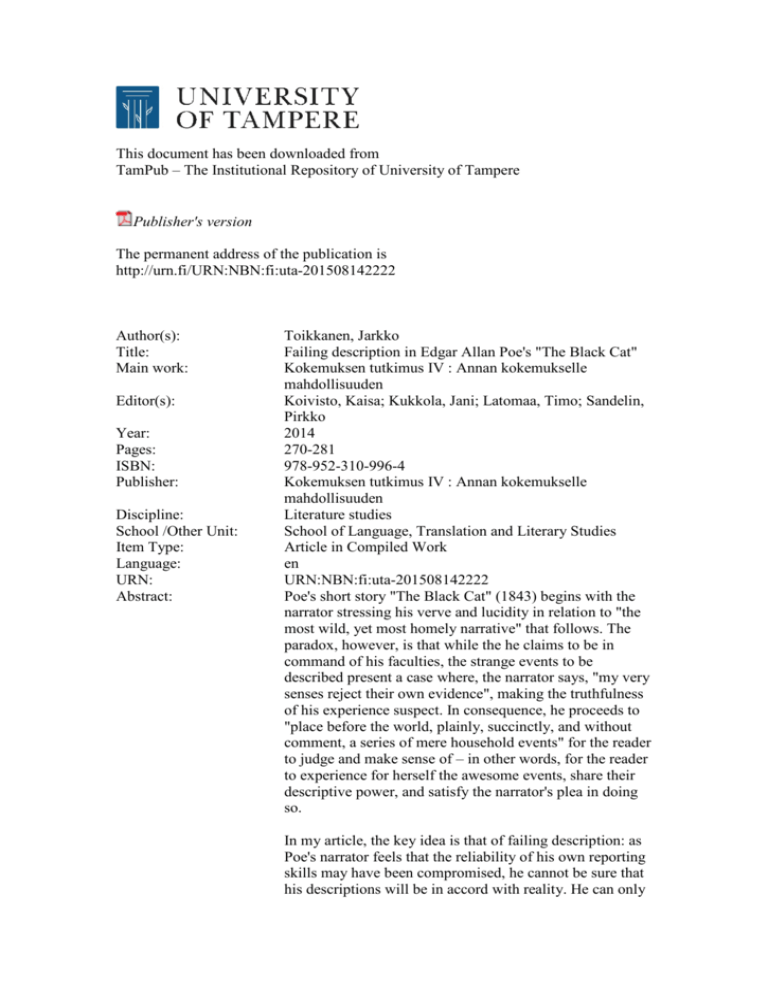
This document has been downloaded from TamPub – The Institutional Repository of University of Tampere Publisher's version The permanent address of the publication is http://urn.fi/URN:NBN:fi:uta-201508142222 Author(s): Title: Main work: Editor(s): Year: Pages: ISBN: Publisher: Discipline: School /Other Unit: Item Type: Language: URN: Abstract: Toikkanen, Jarkko Failing description in Edgar Allan Poe's "The Black Cat" Kokemuksen tutkimus IV : Annan kokemukselle mahdollisuuden Koivisto, Kaisa; Kukkola, Jani; Latomaa, Timo; Sandelin, Pirkko 2014 270-281 978-952-310-996-4 Kokemuksen tutkimus IV : Annan kokemukselle mahdollisuuden Literature studies School of Language, Translation and Literary Studies Article in Compiled Work en URN:NBN:fi:uta-201508142222 Poe's short story "The Black Cat" (1843) begins with the narrator stressing his verve and lucidity in relation to "the most wild, yet most homely narrative" that follows. The paradox, however, is that while the he claims to be in command of his faculties, the strange events to be described present a case where, the narrator says, "my very senses reject their own evidence", making the truthfulness of his experience suspect. In consequence, he proceeds to "place before the world, plainly, succinctly, and without comment, a series of mere household events" for the reader to judge and make sense of – in other words, for the reader to experience for herself the awesome events, share their descriptive power, and satisfy the narrator's plea in doing so. In my article, the key idea is that of failing description: as Poe's narrator feels that the reliability of his own reporting skills may have been compromised, he cannot be sure that his descriptions will be in accord with reality. He can only Subject: promise to tell the story "plainly, succinctly, and without comment", that is, to try to fail as little as possible in describing what happened. This is unsettling for him, and the readers share the effect, a fusion one can study through the concept of experience. I will do this, inspired by the current theoretical interest on emotion and affect. Methods include the rhetorical devices of ekphrasis (verbal representation of a visual representation) and hypotyposis (vivid description of a visual image), and Wayne C. Booth's notion of the unreliable narrator. Edgar Allan Poe; experience; ekphrasis; hypotyposis All material supplied via TamPub is protected by copyright and other intellectual property rights, and duplication or sale of all part of any of the repository collections is not permitted, except that material may be duplicated by you for your research use or educational purposes in electronic or print form. You must obtain permission for any other use. Electronic or print copies may not be offered, whether for sale or otherwise to anyone who is not an authorized user. Failing description in Edgar Allan Poe’s “the black cat” Jarkko Toikkanen Introduction Edgar Allan Poe’s short story “The Black Cat” (1843) begins with the narrator stressing his verve and lucidity in relation to “the most wild, yet most homely narrative” that follows. The paradox, however, is that while he claims to be in command of his faculties, the strange events to be described present a case where, the narrator says, “my very senses reject their own evidence”, making the truthfulness of his experience suspect. In consequence, he proceeds to “place before the world, plainly, succinctly, and without comment, a series of mere household events” for the reader to judge and make sense of – in other words, for the reader to experience for herself the awesome events, share their affective power, and satisfy the narrator’s plea in doing so. In this article, I will discuss the above premise through the concept of experience and its special features that in literature have an impact on one’s understanding of the concept. My key idea is that of failing description: as Poe’s narrator feels that the reliability of his own reporting skills may have been compromised, he cannot be sure that the descriptions that follow will be in accord with reality. He can only promise to tell the story “plainly, succinctly, and without comment”, that is, to try to fail as little as possible in describing what happened. Moreover, as previous readings have shown, when the responsibility is shifted on to the reader to make up her own mind about the events, there is no guarantee that she will fare in the task any better. Interpretations will abound, none the more valid than the next one, and the single definite effect will be that of the unsettling experience of Poe’s failing descriptions in the form of his dark tale, shared between the reading multitude. My theoretical approach is inspired by notable current interest in literary studies on emotion and affect, which relates directly to what kind of an experience reading literature can be and how its effects for different readers can 270 Failing descr iption in Edga r A ll a n Poe’s “the bl ack cat” be qualitatively analysed. Applicable methods include the classical rhetorical devices of ekphrasis (defined as the verbal representation of a visual representation in the Methods section) and hypotyposis (the vivid description of a visual image), how the devices are distinguished from each other, and what kinds of results the distinction can provide in the analysis of a tale such as “The Black Cat”. For research on the concept of experience, the present relevance and future significance of these results will be discussed in the conclusion. Previous readings In “The Black Cat”, during his final night before death by hanging, the narrator gives an account of strange events that have seen him engage in vile criminal activity. Tormented into a mental breakdown through alcoholism and spiritual turmoil, the narrator is despoiled of the “docility and humanity” of his once youthful nature. In his mind, he has fallen prey to the metaphysical “spirit of PERVERSENESS” which is “one of the indivisible primary faculties, or sentiments, which give direction to the character of Man”. He is first led to dispose of his cat Pluto and, when the cat’s double returns to haunt him, finally to put an axe through his wife’s head. Littered with unbelievable coincidences and dubious recollections, the story concludes with the narrator begging the reader for clarity and redemption before his own execution on the following day. Over the years, in response to the explicit wish of the narrator, there have been numerous attempts to judge and make sense of Poe’s disturbing story. Among the most formative, James W. Gargano (1960) reacted critically against the tendency to accept the narrator’s apologetics, or “his specious intellectual dodges” (Gargano 1960, 178), as proof about the “enigmatic imp of the perverse” (Gargano 1960, 172) that one had no control over. Gargano’s claim is that instead of being driven by a metaphysical force, the narrator exhibits an “atrophied moral sense” (Gargano 1960, 175), the responsibility of which he attempts to waive. In turn, Ed Piacentino (1998) has firstly provided a catalogue of many of these previous readings – a list that anyone looking for further sources might be interested in – and secondly he has ventured to suggest his own solution to the story’s main conundrum. Why does the narrator kill his wife? What is his motive for such a heinous act? Making use of Gerard 271 Ja r k ko Toik k a n en Genette’s notion of narrative, Piacentino begins from the idea that “narrative, in contrast to dramatic depiction… serves as a device the author uses to tell or suggest to the reader information that may be unknown to the characters in a work of fiction” (Piacentino 1998, 156). Consequently, the reader gathers that because the narrator himself may be unaware of the ultimate cause for his behaviour, one should take his confessions and explanations with more than a grain of salt. After all, it might be the case that he is simply lying or, perhaps more worryingly, that he believes he is telling the truth and nothing but the truth. Observing the clues provided by the text, Piacentino ultimately identifies the “deep-seated and suppressed anxieties” (1998, 158) of the narrator’s psychobiography as the solution to the mystery why he kills his wife. The deed becomes “a definite act of rejection, vindicating what he had suffered as a child and had been subconsciously carrying with him since that time” (Piacentino 1998, 165). The rationale of the story, in other words, is carefully extracted through psychoanalytical means. As Joseph Stark (2004) has noted, quite a few interpretations of “The Black Cat”, in addition to Piacentino’s, have been attracted by “psychological examinations of the narrator and author” (Stark 2004, 255). One reason for this tendency could be the fact that readers cannot bear “a motiveless murderer whose actions cannot be sufficiently explained” (Stark 2004, 255), and due to this inability the psychological critic’s solution “may indicate more about our longings as readers than about the evidence of the text” (Stark 2004, 261). I concur with Stark, and will reclaim this point in the conclusion. Meanwhile, Susan Amper (1992) has gone the other way to assume the juror’s role in trying “to separate the real from the imagined” (Amper 1992, 476) in Poe’s story. In deliberating “the statements of someone accused of a crime” (Amper 1992, 478), she finds the narrator in full command of his faculties and simply lying about everything. By understanding “The Black Cat” in a strictly generic fashion, as “Poe’s best detective story” (Amper 1992, 485), she deflates the reading experience into little more than an exercise for one’s intellectual muscle, thereby meeting the narrator’s initial request. Elsewhere, Richard Badenhausen (1992) has done roughly the same thing in suggesting that as readers play “the role of attentive jury” (Badenhausen 1992, 490), it is their moral duty to expose the narrator’s “rhetorical tricks” (Badenhausen 1992, 496) and so find their own way of explaining the seemingly inexplicable events. However, drawing on Poe’s critical writings, as 272 Failing descr iption in Edga r A ll a n Poe’s “the bl ack cat” Badenhausen focuses on the “certain unique or single effect to be wrought out” in fiction (Poe quoted in Badenhausen 1992, 488, emphasis in the original), he actually brings out a dimension of literary experience that neither Amper nor Piacentino appears to fathom: Our response to the narrator’s language is finally what the tale is about; and as a result, it succeeds in breaking the fictional barrier by generating real fear in the reader (Badenhausen 1992, 496). What is the source of this “real fear in the reader”, and why is there a need to stamp out the experience by identifying rational motives and solutions, psychological or generic, for Poe’s story? With nothing but tropes and figures to hang on, what if the reader’s “response to the narrator’s language” had her fail in the explicative task altogether? Methods The classical rhetorical devices of ekphrasis and hypotyposis provide a specific method with which the words and images of literature may be productively studied. What is more, making an intermedial distinction between their uses can help in establishing how and why they give rise to different reading effects. I have argued in my recent monograph The Intermedial Experience of Horror: Suspended Failures (2013) that whereas ekphrasis, as the verbal representation of a visual representation, requires that an act of interpretation be carried out, hypotyposis, as the vivid description of a visual image, makes no such requirement. In other words, when reading a literary text begins to generate images in the reader’s mind – such as the uncanny appearance of the second cat or the gruesome decay of the wife’s corpse at the end of “The Black Cat” – reading the images ekphrastically calls for their meaning to be explained, whereas, as hypotyposes, they are merely seen in the mind’s eye. In this sense, the interpretive trigger of ekphrasis creates reading experiences such as those shared by Piacentino and Amper about Poe’s story and, as I must stress, there is nothing “wrong” in this descriptive action: wanting to explain the unexplainable is a common urge. Nevertheless, as noted by Stark and Badenhausen, the urge might betray other, more 273 Ja r k ko Toik k a n en formal ways of observing the story, including the rhetorical causes and consequences of different reading effects. In the analysis part of my article, I look more closely into how these effects play out in practice in “The Black Cat”, either as ekphrases or hypotyposes, and try to figure out how one’s experience of the story is affected accordingly. Before going there, however, introducing one further methodological notion can be a helpful thing to do. As the speaker figure in Poe’s story is quite clearly someone who is not to be trusted for his word, he can be conceptualised as an unreliable narrator, a literary theoretical notion invented by Wayne C. Booth back in 1961. While the figure, as Booth tentatively outlined it in The Rhetoric of Fiction, has since then been both challenged and refined by critics such as Seymour Chatman and Ansgar Nünning, I will here make use of Booth’s original definition as it appears pertinent to an analysis of aspects of Poe’s narrator. He talks about “kinds of distance” (Booth 1961, 159) between fictional narrators and real-life authors or readers that have a bearing on how one comes to judge “the moral and intellectual qualities of the narrator” (Booth 1961, 159). One such type of distance is generated by way of the narrator being “discovered to be untrustworthy”, in consequence of which “the total effect of the work he relays to us is transformed” (Booth 1961, 159). Booth then struggles to find the definitive term for the effect identified, offering the oft-quoted definition as his makeshift solution: Our terminology for this kind of distance in narrators is almost hopelessly inadequate. For lack of better terms, I have called a narrator reliable when he speaks for or acts in accordance with the norms of the work (which is to say, the implied author’s norms), unreliable when he does not. (Booth 1961, 159) A narrator, in other words, can be trusted when there is no need to doubt his “moral and intellectual qualities” from a normative viewpoint. Then again, should suspicion about his person be aroused, he may be deemed to be an unreliable narrator, which affects the way he is read. In “The Black Cat”, the suspicion is certainly there. As the reader hangs on the words of Poe’s narrator and the images generated by his words, there is no other material foundation available for one’s experience of the story. This means that any lapse into failure on the narrator’s part – whether in 274 Failing descr iption in Edga r A ll a n Poe’s “the bl ack cat” disbelieving the evidence of his own senses or in describing any sequence of events truthfully – is also a failure on the reader’s part. One can certainly attempt to know better than the narrator, which is what he indeed asks us to do, but the state of our complete dependence on his testimony, or lack thereof, will not cease to exist. We may think to have explained him from an objective viewpoint, in the style of Piacentino and Amper, but, as a matter of fact, the readers have only shared their own reading experiences with other readers, affected and directed by their relation to the text’s rhetorical elements, the unreliable narrator included. In this sense, in addition to the ekphrases and hypotyposes of “The Black Cat”, the reader’s personal response to the narrator, the level of one’s trust towards him – or whether he is felt to deserve sympathy or not – must be taken into account in the story’s analysis, as well. Forging such a relationship with a fictional character is therefore an intimate experience, a stepping into someone else’s mind that runs the risk of deception. However, because of the sense of intimacy, it is still a risk that time after time readers are willing to take, wanting to see and feel what someone else sees and feels: [A]ny sustained inside view, of whatever depth, temporarily turns the character whose mind is shown into a narrator; inside views are thus subject to variations in all of the qualities we have described above, and most importantly in the degree of unreliability. Generally speaking, the deeper our plunge, the more unreliability we will accept without loss of sympathy. (Booth 1961, 164) With “The Black Cat”, plunging into the narrator’s mind may seem like an unnecessary risk as one cannot be sure, while still drawing on one’s sympathy, of the extent of his moral corruption or even insanity. In the following, however, I will counter that risk with the tools laid out above. Analysis: Failing description One technique of measuring the level of the unreliable narrator’s failing description and, based on that, the degree to which readers share the experience of failing to explain “The Black Cat”, is by focusing on specific key 275 Ja r k ko Toik k a n en passages. For the purpose, I have identified four turning points in the text that, in my view, exemplify ekphrasis and hypotyposis and support my chosen approach. In doing so, the aim is to learn and evaluate the structural importance of these devices to the story. The first passage appears near to the beginning of Poe’s tale. In providing a list of the various pets the couple keeps in their home, the narrator makes initial reference to the big, smart and beautiful cat of whom the wife apparently has her own story to tell: In speaking of his intelligence, my wife, who at heart was not a little tinctured with superstition, made frequent allusion to the ancient popular notion, which regarded all black cats as witches in disguise. Not that she was ever serious upon this point – and I mention the matter at all for no better reason than that it happens, just now, to be remembered. At the point of the passage, the narrator has only started to recount his story, to go through his memories, and offer the reader the starting point for the “series of mere household events” that follows. Yet almost immediately there is a flashback to the present as another apparently trivial fact intrudes upon his thought process, changing the way how past events might be understood: that his wife believed all black cats to be witches, or at least she used to joke about believing so. The fact seems coincidental – “it happens, just now, to be remembered” – and the paragraph ends there, not developing its significance further. However, the way in which the story proceeds, and the imagery that it generates, has been changed by the coincidence. As I put it in defining my methodology above, reading the images of literature ekphrastically calls for their meaning to be explained, whereas, as hypotyposes, they are merely seen in the mind’s eye. In this instance, the effect is twofold. On the one hand, with the narrator’s casual reference to a belief about witches, each subsequent cat image appearing in Poe’s story will be fraught with ekphrastic reference to entities of this kind. On the other hand, to many readers such a reference will appear nonsensical, and so they will strive to keep the cat images hypotypotically clean of the influence – just as the narrator hopes that they would do, with intellects that are “more calm, more logical, and far less excitable” than his own. The tension created, however, cannot be easily resolved, and that casts a shadow on how everything that follows is experienced. 276 Failing descr iption in Edga r A ll a n Poe’s “the bl ack cat” Going on to lament his defeat by alcoholism, and the metaphysical dimensions the “Fiend Intemperance” assumes in his addled mind, the narrator reveals his intensifying drive to violence that everyone around him is exposed to. Eventually he hangs the couple’s cat from a tree, for the reason of doing “wrong for the wrong’s sake only” and, on that very night, their house burns down. In the turmoil, only one of the walls remains erect, bearing on its surface “the figure of a gigantic cat” with “a rope about the animal’s neck”. To explain the mysterious appearance, the narrator comes up with a ludicrous explanation that hardly bears the scrutiny of “a chain of facts” that he claims to have forged. As a result, his unreliability factor is boosted, the imagery left unexplained. Afterwards, living in a new home, the origin of which also remains obscure, the memory of the events continues to haunt him, shifting from dread and confusion into remorse: I went so far as to regret the loss of the animal, and to look about me, among the vile haunts which I now habitually frequented, for another pet of the same species, and of somewhat similar appearance, with which to supply its place. His habit, in other words, turns into an ekphrastic obsession of finding a new visual object that could be verbally described as representing the previous one. It is not as if the narrator would be content with any cat whatsoever – with “another pet of the same species” – but he must find an object that will substitute for late Pluto and keep the pet’s meaning alive. And, surely enough, such a doppelganger he indeed retrieves during one of his drunken binges about the town. For a while, things look good for the new cat as he becomes “a great favorite” with the narrator’s wife, but soon the narrator himself starts to feel differently. At first it is a mere dislike of the beast – which is “the reverse of what [he] had anticipated” – that gradually morphs into hatred and finally into a mixture of fear and loathing. The reason for the fear is expressed in another key passage where it is revealed how the sole difference in appearance between Pluto and the new cat, an “indefinite splotch of white” in the latter’s breast, has been transforming lately: 277 Ja r k ko Toik k a n en The reader will remember that this mark, although large, had been originally very indefinite; but, by slow degrees – degrees nearly imperceptible, and which for a long time my Reason struggled to reject as fanciful – it had, at length, assumed a rigorous distinctness of outline. It was now the representation of an object that I shudder to name […] The “representation of an object” that so unsettles the narrator is the image of the “GALLOWS!” that immediately not only revives the memory of Pluto’s wretched fate but also forebodes the method of his own demise on the following day. On the one hand, thematically speaking, one could explain the meaning of the image in several ways, adding a host of interpretive layers to one’s descriptive analysis of “The Black Cat” in the style of Piacentino and Amper. On the other hand, in a more formal observation, it is clear that without the ekphrastic image of the gallows and other significant representations of visual objects, any descriptive interpretation of Poe’s story would be without foundation and the reading experience would dissipate. Then again, if the reader, in response to the narrator’s wish, once more strove to keep the gallows image clean of referential influences – strove to treat it as a hypotyposis – one could not begin to put together a coherent reading of the entire narrative. For if one does not believe that the images generated in reading signify nothing in particular, and they are there just to be seen, no story can be traced at all. In this sense, plain description seems unproductive, if not impossible. However, as the reader of Poe’s story takes steps to add meaning to seeing, the process is not without tension because then one is exposed to the unreliable narrator’s ekphrastic manipulation of his tale. And such an advantage always allows him to retain the upper hand, no matter what he might ask us to do. The point of my inquiry is this: because Poe’s narrator fails in his description, so do we as readers fail in describing what “The Black Cat” means, but precisely because we do fail, we can experience the story for ourselves and share it with others through our failed attempts to avoid such failure. In a way, there is no sense in pretending that one has outwitted Poe’s narrator or extracted the meaning of the story for any set purpose like the psychoanalytical or the purely intellectual. At the same time, however, if one does not try at all, the inquiry stops right there. As the narrator eventually kills his wife in a fit of insanity, there is evidence to deduce that the act is motivated by jealous transference – the new Pluto did become attached to the wife in a 278 Failing descr iption in Edga r A ll a n Poe’s “the bl ack cat” manner that reminded the narrator of “that humanity of feeling” he too had once possessed but then lost. Moreover, as the cat subsequently goes missing, and the narrator feels exhilarated with how things have suddenly turned out (“My happiness was supreme! The guilt of my dark deed disturbed me but little.”), there is no denying the worth of the psychoanalytical claim. Yet, as I have been saying, a competing interpretation based on another viewpoint might contest that claim and describe a different answer to the story’s question. Perhaps, as put by James W. Gargano, the whole point is the narrator’s failure to take responsibility for his “transparently moral adventure” (Gargano 1960, 1978), or perhaps, as Susan Amper suggested, it is all just a big cover-up designed by a mendacious narrator to misguide the jury about to sentence him to death. Or maybe it is something completely else. Be that as it may, each reading of “The Black Cat” will hang on the words and images that make up the story, and the experience of each and every reader of Poe’s disturbing tale will be defined by the individual reader’s response to the unreliable narrator’s manipulation of those very words and images. At the climax of the story, when the narrator is undone by an unwarranted sense of superiority of having got away with his crimes, the final key passage appears. The police have come to search his house for clues on the disappeared wife and when they reach the cellar, he raps with his cane, in an act of wild hubris, on the exact spot where her body is walled up. This evokes a “long, loud, and continuous scream, utterly anomalous and inhuman… half of horror and half of triumph” from inside the wall, striking the narrator into a state of incoherence: Of my own thoughts it is folly to speak. Swooning, I staggered to the opposite wall. For one instant the party upon the stairs remained motionless, through extremity of terror and of awe. In the next, a dozen stout arms were toiling at the wall. It fell bodily. By the time the cellar wall crumbles to reveal the wife’s decomposing cadaver, the last shred of the narrator’s reliability has been removed through sheer disbelief and terror. For although there is no trusting him at any stage of the story, a single moment of clarity appears at the point when he recognises the “folly” of telling anything anymore, of pretending that he would not fail in what he describes. By closing abruptly on this revelation, the story’s 279 Ja r k ko Toik k a n en final images hardly merit forensic value that would hold up in the court of ekphrastic interpretation – even if one wondered why the wife’s body was already “greatly decayed” or if the cat was indeed a supernatural entity. A textual fact is that as the cellar wall falls, so do the remains of the narrator’s description. For the moment, he has no recourse except to hypotyposis, to images as sheer images that the reader must witness – images that fall on her “bodily” to generate real fear – together with the terror-struck police on the basement stairs. In effect of such subjection and shock, one’s powers of explanation are perhaps only relieved in emulating the narrator: in going back to the beginning of the story to reclaim a calm intellect, by attempting to interpret and describe the unsettling events again, by sharing the experience of the words and images of “The Black Cat” all over again. Conclusion As regards research on the concept of experience, reading and analysing literature with the help of rhetorical devices and literary theoretical notions, as I have proposed to do here, is significant in at least three ways. Firstly, reading is an emotive experience that affects one beyond the purely intellectual. In that sense, even if one felt that their process of deductive reasoning was the proper course of action in solving a literary text, it can be indicated that such acts are, nevertheless, affectively motivated. As Joseph Stark suggested, interpretive solutions of this kind may tell more “about our longings as readers than about the evidence of the text” (Stark 2004, 261). Secondly, individual experiences are shared experiences. It is obvious that everyone will have their own reading, their own experience, of a literary text, and no two readings will be quite alike. This, however, does not mean that the discussion stops there. In “The Black Cat”, the narrator cannot find peace for his sins and he is fated to continue to share his story with others, trying to make sense of his own experience and calling for others to add their own. As readers, we respond in sympathy and are invited to live by the tropes and figures with which the narrator taunts and torments us, staring in horror at his dark revelations, not knowing who or what to trust. Thirdly and perhaps most pointedly, as readings are based on texts, so too are the experiences based on texts. The unreliable narrator of Poe’s story takes his reader on a sinister ride through mixed 280 Failing descr iption in Edga r A ll a n Poe’s “the bl ack cat” recollections, disturbing sights, and strange intimations that gains its momentum from the very words and images that give it form. Not losing sight of this fact is crucial in the sense of knowing that whatever a text signifies, in literature or some other form of human interaction, it will signify as the result of its vital elements. It will not signify because of anything else, and it is for that reason exactly that interpretations and ideas not based on a careful reading, a strong experience, of any text at stake will remain at a disadvantage. In this article, I have applied the devices of ekphrasis and hypotyposis to avoid that pitfall. In the process, I hope to have shown how the failing descriptions of literature matter in understanding experience for theoretical research. Works cited Amper, S. (1992). Untold Story: The Lying Narrator in “The Black Cat”. Studies in Short Fiction, 29(4), 475–485. Badenhausen, R. (1992). Fear and Trembling in Literature of the Fantastic: Edgar Allan Poe’s “The Black Cat”. Studies in Short Fiction, 29(4), 487–498. Booth, W. C. (1961). The Rhetoric of Fiction. Chicago and London: The University of Chicago Press. Gargano, J. W. (1960). “The Black Cat”: Perverseness Reconsidered. Texas Studies in Literature and Language, 2(2), 172–178. Piacentino, E. (1998). Poe’s “The Black Cat” as Psychobiography: Some Reflections on the Narratological Dynamics. Studies in Short Fiction, 35(2), 153–167. Poe, E. A. (1843). “The Black Cat”. The Literature Network. [accessed on 3 Dec 2013] Available at: <http://www.online-literature.com/poe/24/> Stark, J. (2004). Motive and Meaning: The Mystery of the Will in Poe’s “The Black Cat”. Mississippi Quarterly, 57(2), 255–263. Toikkanen, J. (2013). The Intermedial Experience of Horror: Suspended Failures. Basingstoke: Palgrave Macmillan. 281
